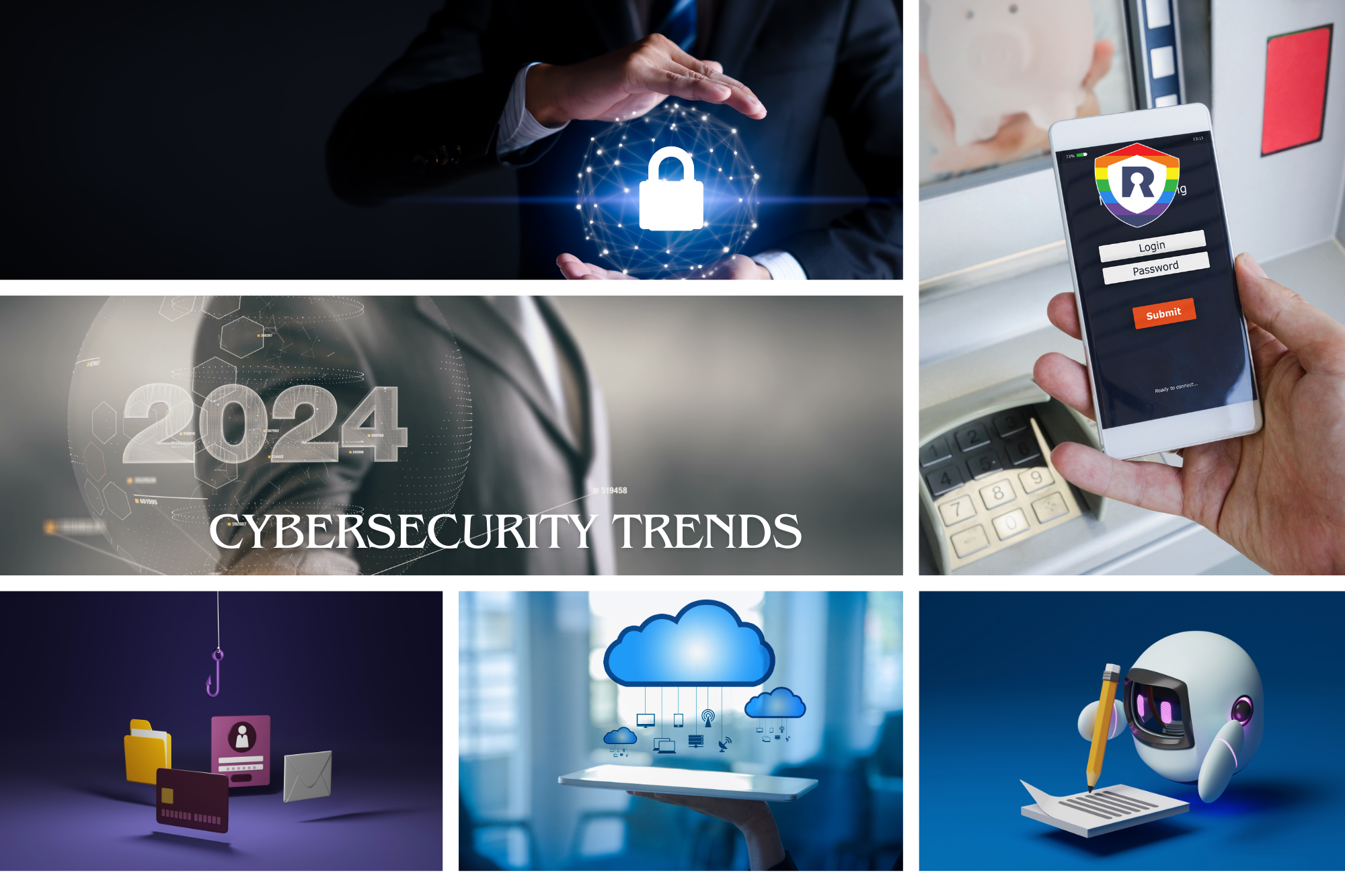Cybersecurity Trends for 2024: Navigating the Evolving Digital Landscape
As we step into 2024, the digital landscape continues to evolve at an unprecedented pace, accompanied by an ever-growing threat landscape. Cybersecurity has become more crucial than ever, with organizations and individuals alike facing sophisticated cyber threats. To stay ahead of cybercriminals, it’s essential to be aware of the latest trends shaping the cybersecurity landscape in 2024.
In this article, you will read about latest cybersecurity trends for 2024:
1. Artificial Intelligence and Machine Learning in Cybersecurity
In 2024, the integration of artificial intelligence (AI) and machine learning (ML) technologies into cybersecurity solutions is becoming increasingly prevalent. These technologies enable systems to analyze vast amounts of data rapidly, identify patterns, and detect anomalies that might indicate a cyber threat. AI and ML-powered cybersecurity tools enhance threat detection accuracy, reduce false positives, and improve overall response times.
2. Zero Trust Architecture
The traditional perimeter-based security approach is no longer sufficient in today’s dynamic and distributed digital environment. Zero Trust Architecture (ZTA) has gained prominence as a security model, emphasizing the principle of “never trust, always verify.” ZTA assumes that threats can originate both from external and internal sources, requiring continuous authentication and authorization for users and devices, irrespective of their location.
3. Cloud Security
The accelerated adoption of cloud services continues to reshape the cybersecurity landscape. Organizations are increasingly migrating their operations to the cloud, introducing new security challenges. As a result, cloud security has become a top priority. In 2024, expect to see a focus on enhancing cloud security frameworks, encryption mechanisms, and identity and access management (IAM) solutions to safeguard data stored in cloud environments.
4. Quantum Computing Threats and Post-Quantum Cryptography
While quantum computing holds immense promise for various industries, it also poses a significant threat to existing cryptographic methods. In 2024, there is a growing emphasis on developing and adopting quantum-resistant or post-quantum cryptography. Organizations are investing in researching and implementing cryptographic algorithms that can withstand the computational power of quantum computers, ensuring the long-term security of sensitive data.
5. Enhanced Threat Intelligence Sharing
Collaboration among organizations, governments, and cybersecurity communities has become crucial in the fight against cyber threats. In 2024, expect to see an increase in threat intelligence sharing initiatives. Organizations are recognizing the importance of sharing information on emerging threats, attack techniques, and vulnerabilities to collectively strengthen their defenses against cyber adversaries.
6. Ransomware Resilience and Mitigation:
Ransomware attacks have become more sophisticated and prevalent, causing significant financial losses and disruptions. In 2024, there is a heightened focus on ransomware resilience and mitigation strategies. This includes regular data backups, employee training and awareness programs, and the implementation of advanced threat detection and response mechanisms to minimize the impact of ransomware attacks.
7. Next-Level Phishing Attacks: Increased Sophistication
Phishing attacks have long been a persistent threat in the cybersecurity world, and in 2024, they continue to evolve in sophistication and effectiveness. Social engineering attacks that trick users into giving attackers access to systems will become more advanced, thanks to the rise of generative AI tools like ChatGPT and deepfake attacks. These approaches will become increasingly personalized, making them harder to detect. The response to this will largely revolve around organization-wide awareness and education, although AI and zero trust will play a growing role, too. To protect against these advanced phishing attacks, robust authentication systems are key to enhancing security.
8. Mobile Security
As mobile devices become more important for both personal and professional use, there is a growing emphasis on mobile security. The increased reliance on mobile devices for tasks such as remote work, financial transactions, and personal communication makes them attractive targets for cyber threats. Robust mobile security solutions will be a necessity in the coming years.
9. Insider Threats
Insider threats, such as human error, remain a primary reason for data breaches. A Verizon report revealed that 34% of total attacks were directly or indirectly caused by employees. It is important to increase awareness and educate employees on safeguarding data to prevent any intentional or unintentional data breaches.
10. LLM Powered Services
LLM-powered services are becoming increasingly popular for business workflows, but they pose a risk to data security. Malicious prompt injections can manipulate LLMs to divulge sensitive data, creating compliance violations and fines. Companies will need to take proactive measures to prevent adversarial prompts from compromising data security, setting the stage for a new set of solutions to mitigate such challenges.
11. Multi-factor authentication (MFA)
Multi-factor authentication (MFA) is becoming the standard for securing accounts and data. MFA adds an extra layer of security by requiring users to provide multiple forms of verification. In 2024, MFA will be a non-negotiable security measure for businesses and individuals alike. Its adoption will surge as organizations prioritize safeguarding sensitive data.
12. State-sponsored warfare
State-sponsored cyberattacks and espionage will continue to rise in 2024. Such attacks can have significant geopolitical implications and disrupt critical infrastructure. Countries will need to strengthen their cybersecurity defenses and work together on international cybersecurity initiatives to mitigate threats.
13. The Potential Impact of Cyber Attacks on IoT Devices
The Internet of Things (IoT) has opened up several opportunities for cybercrime, presenting new challenges for online security. Physical devices, including wearables, smart appliances like refrigerators, voice assistants and smartwatches, are all examples of IoT devices that connect to the internet and exchange data. The number of IoT devices installed worldwide is expected to reach 64 billion by 2026, driven in part by the shift towards remote work. However, these devices’ additional number changes the dynamics and size of the cyber-attack surface, increasing the potential entry points for malicious actors. Compared to laptops and smartphones, most IoT devices have fewer processing and storage capabilities, making it harder to install firewalls, antivirus, and other security applications to protect them. As a result, IoT attacks have become one of the most pressing cyber-attack trends.
14. The Widening Gap in IT Skills
As the need for capable cybersecurity professionals grows, the availability of qualified workers is decreasing. It is expected that the IT skills gap will continue to widen until 2024, making it increasingly difficult for companies to find the right experts to manage their security requirements.
Investing in staff training and development programs is crucial to upskill existing employees and attract new talent. Ignoring the pressing issue of the shortage of cybersecurity experts is not an option.
As we navigate the complex and ever-changing digital landscape of 2024, staying ahead of cyber threats requires a proactive and adaptive approach to cybersecurity. The trends mentioned above underscore the importance of leveraging advanced technologies, rethinking security architectures, and fostering collaborative efforts to mitigate the evolving cyber risks. Organizations and individuals must remain vigilant, invest in cybersecurity measures, and stay informed about the latest developments to safeguard against the dynamic and sophisticated nature of cyber threats in the years to come.
Rainbow Secure plays a pivotal role in fortifying your business against cyber threats. In an era where digital security is no longer optional but a necessity, Rainbow Secure stands as a guardian, offering robust, user-friendly, and compliant security solutions.
- Enhanced Security: Rainbow Secure’s multi-dimensional approach to security, incorporating unique color and style-based authentication, has redefined the meaning of ‘secure login’. By protecting against threats like keyloggers, brute force, and phishing attacks, we ensure that the critical infrastructure sector can operate in the digital realm with confidence and peace of mind.
- Simplified User Experience: Understanding that complexity is the enemy of security, Rainbow Secure has revolutionized the user experience. Our intuitive and customizable login process not only enhances security but also fosters user engagement and compliance. This ease of use is critical in ensuring that security measures are consistently and effectively implemented across organizations.
- Compliance and Regulation: In today’s regulatory landscape, compliance is not just about checking boxes. It’s about protecting reputations, building trust, and ensuring long-term sustainability. Rainbow Secure helps critical infrastructure sector navigate this complex terrain, adhering to stringent standards like GDPR, HIPAA, and NIST, among others. Our commitment to compliance is a testament to our dedication to not just meeting, but exceeding, the highest standards of data protection and privacy.
How can Rainbow Secure help?
Right amount of data and system access to right person or role at right time is the key to organizations being able to use digital tools and platforms to serve the customer base and stay compliant.
Next Generation Rainbow Secure platform is a modern identity authentication (MFA) and single sign- on (SSO) solution for your business across on-premises and cloud environments. It’s backed by an experienced team of cloud and security experts, years of innovation, and partnerships with leading cloud platforms. Rainbow Secure is a Leader in Smart and Secure Digital Solutions that work for you.
Insider Threats: Rainbow Secure assists in mitigating insider threats by implementing access controls, user monitoring, and privilege management solutions. Also, if the user leaves behind unlocked devices, saved passwords in the password manager or browser can be misused by malicious insiders. Interactive login security from Rainbow Secure helps prevents unauthorized access and protects against data theft or misuse by privileged users.
ChatGPT Security for business: Secure your ChatGPT login and Data with Rainbow Secure MFA Plugin.
Secure AI Integration: Consult Rainbow Secure Team to integrate AI in your business workflows powered by Azure and Rainbow Secure API.
Secure Workforce & Customer login: Use Authentication Plug-in by Rainbow Secure to secure workforce and customer logins. In this plug-in, you get a multi-dimensional password, passwordless login solutions with AI monitoring, Risk Analytics, and location fencing.
IoT Friendly Security: IoT platform developers can secure their cloud endpoints, and user logins (both admin and customer) against unauthorized access and scripted malware attacks using easy to adapt and support multi-layer interactive rainbow secure authentication solutions and services that includes but not limited to security assessment, API Security, secure user onboarding, and risk analytics.
Secure Data and its Backups We provide Cloud based data vault and data archive solutions backed by Microsoft Azure and secured by our authentication plugin and industry best practices to give you ransomware protection, help with data governance and disaster mitigation.
Database Security We provide technical consulting services to Secure Databases in cloud and on premise. You get best protection for your data in databases using native and third-party security tools.
Meet Compliance Requirements: Use Authentication Plug-in by Rainbow Secure with your business application and in SSO (Single Sign-on) and meet industry standards and compliance regulations such as NIST, ISO, FTC, SOX, SOC2, CMMC, CMMI, HIPAA, PCI, and others.
Securely communicate and Collaborate: Use Secure Business Email by Rainbow Secure and get protection against account takeover, phishing, ransomware, and automated login cyber frauds. In this email, you get options to send encrypted emails, single sign-on with Office 365, and Google, and 1 TB one drive storage.
Connect Business applications: Get one unified login using Rainbow Secure Single Sign-On
Manage User Onboarding / Offboarding using Rainbow Secure IAM
Verify User using Smart Multi-factor MFA. Smart Multi-Factor Authentication from Rainbow Secure which adjusts to your use case, reduces the cyber liabilities of a business from stolen credentials and improves productivity, and enhances user experience.
Do you have more questions about how Rainbow Secure’s innovative solutions help to enhance your security posture and safeguard your business from cyber threats and attacks? Contact us today. Email us at Hello@rainbowsecure.com







